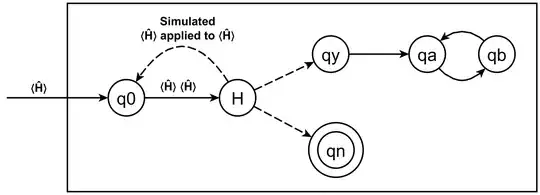// Linz Turing machine H --- H applied to ⟨H⟩
H.q0 ⟨H⟩ ⟨H⟩ ⊢* H.qy // H applied to ⟨H⟩ halts
H.q0 ⟨H⟩ ⟨H⟩ ⊢* H.qn // H applied to ⟨H⟩ does not halt
Do you halt on your own Turing Machine description ?
Of the infinite set of implementations of H every one that transitions to H.qy derives an answer consistent with the behavior of H.
When we append an infinite loop to the H.qy state we derive Ȟ
Ȟ.q0 ⟨Ȟ⟩ ⟨Ȟ⟩ ⊢* Ȟ.qy ∞ // Ȟ applied to ⟨Ȟ⟩ halts
Ȟ.q0 ⟨Ȟ⟩ ⟨Ȟ⟩ ⊢* Ȟ.qn // Ȟ applied to ⟨Ȟ⟩ does not halt
Do you halt on your own Turing Machine description ?
Of the infinite set of implementations of Ȟ none of them derives an answer consistent with the behavior of Ȟ.
This is because the question:
Do you halt on your own Turing Machine description ?
is self-contradictory thus incorrect question for Ȟ.
Yes/no questions intentionally defined to have no correct yes/no answer are incorrect questions. The inability to correctly answer an incorrect question places no actual limit on anyone or anything.
Two PhD computer science professors agree with this view:
E C R Hehner. Objective and Subjective Specifications WST Workshop on Termination, Oxford. 2018 July 18. See https://www.cs.toronto.edu/~hehner/OSS.pdf
Bill Stoddart. The Halting Paradox 20 December 2017 https://arxiv.org/abs/1906.05340 arXiv:1906.05340 [cs.LO]
Prior question
Applying a Simulating Halt Decider to the Linz Halting Problem Proof
A simulating (at least partial) halt decider correctly predicts whether or not its correctly simulated input can possibly reach its own final state and halt. It does this by correctly recognizing several non-halting behavior patterns in a finite number of steps of correct simulation. Inputs that do terminate are simply simulated until they complete.
The Linz text indicates that Ĥ is defined on the basis of prepending and appending states to the original Linz H, (assumed halt decider) thus is named embedded_H.
(q0) is prepended to H to copy the ⟨Ĥ⟩ input of Ĥ. The transition from (qa) to (qb) is the conventional infinite loop appended to the (qy) accept state of embedded_H. ⊢* indicates an arbitrary number of moves.
The Linz term “move” means a state transition and its corresponding tape head action {move_left, move_right, read, write}. Ĥ is applied to its own machine description ⟨Ĥ⟩.
Ĥ.q0 ⟨Ĥ⟩ ⊢* embedded_H ⟨Ĥ⟩ ⟨Ĥ⟩ ⊢* Ĥ.qy ∞
Ĥ.q0 ⟨Ĥ⟩ ⊢* embedded_H ⟨Ĥ⟩ ⟨Ĥ⟩ ⊢* Ĥ.qn
When Ĥ is applied to ⟨Ĥ⟩
(q0) The input ⟨Ĥ⟩ is copied then transitions to (qx)
(qx) embedded_H is applied to ⟨Ĥ⟩ ⟨Ĥ⟩ (input and copy)
which simulates ⟨Ĥ⟩ applied to ⟨Ĥ⟩ which begins at its own (q0) to repeat the process.
This process continues to repeat until embedded_H recognizes the repeating pattern and aborts its simulation of ⟨Ĥ⟩ ⟨Ĥ⟩. embedded_H can see the same repeating pattern that we see.
computation that halts… “the Turing machine will halt whenever it enters a final state” (Linz:1990:234)
Every "rebuttal" simply ignores this key fact
⟨Ĥ⟩ ⟨Ĥ⟩ correctly simulated by embedded_H cannot possibly reach its own simulated final state of ⟨Ĥ.qn⟩ and halt in any finite number of steps of correct simulation.
Linz, Peter 1990. An Introduction to Formal Languages and Automata. Lexington/Toronto: D. C. Heath and Company. (317-320)


